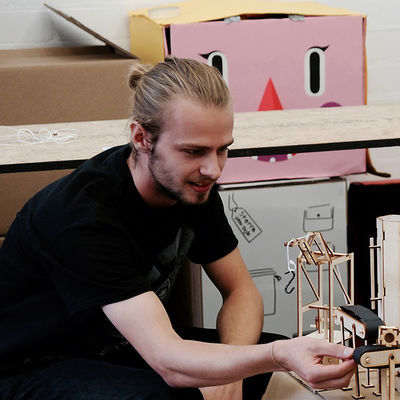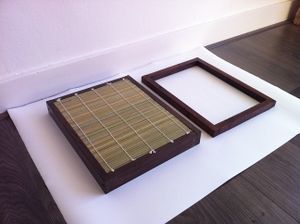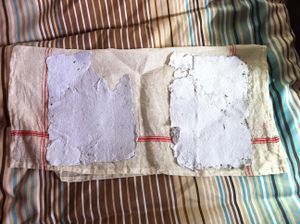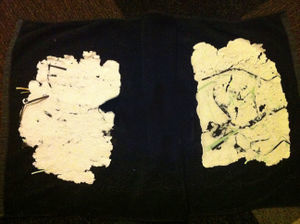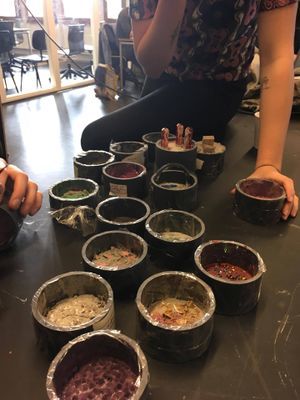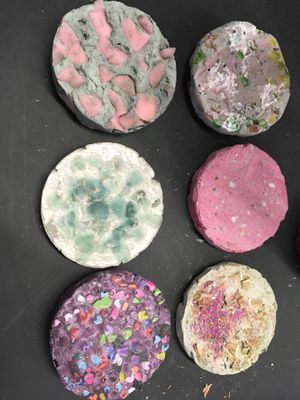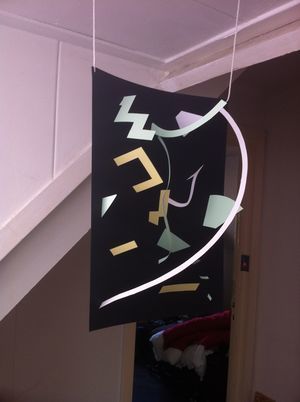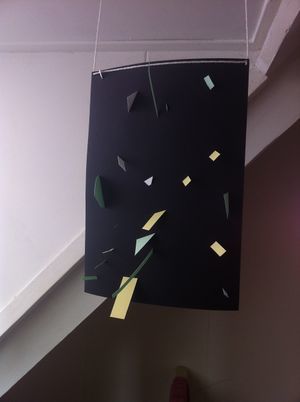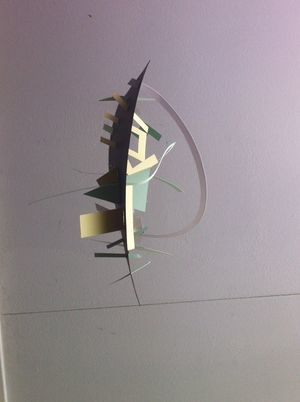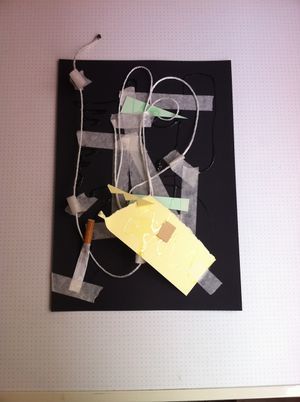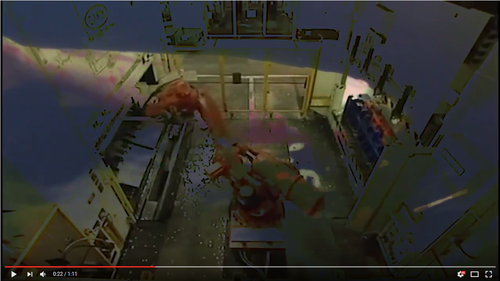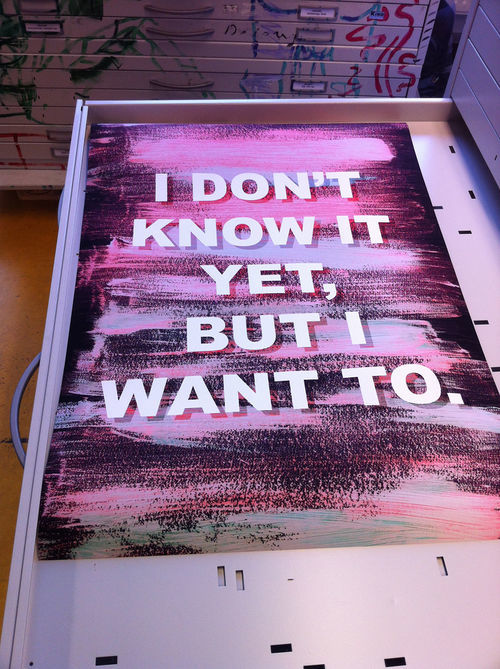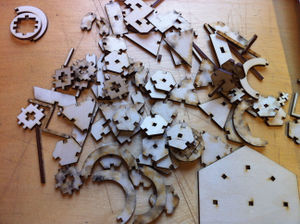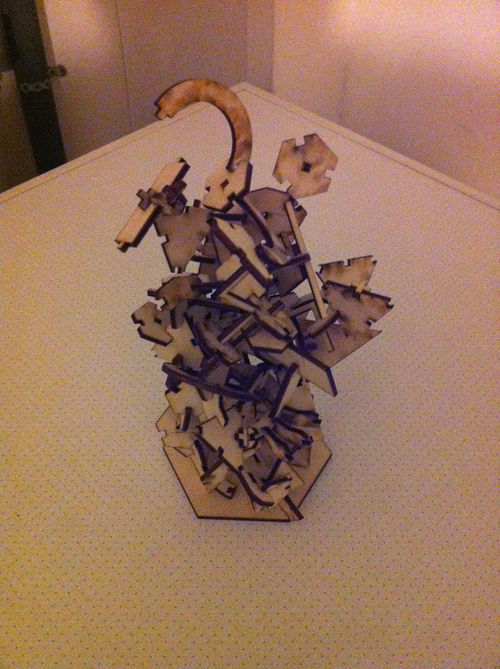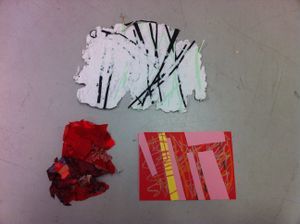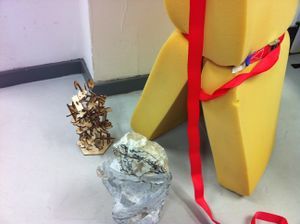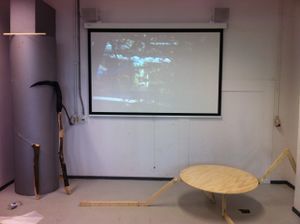User:Max
Max Terpstra Illustratie
email 0908471@hr.nl
5 FUSING EXAMPLES
1 - Historical piece - Paper
The craft of paper making is an ancient craft that originated in China around 105 BC. The craft is based on turning water and natural products (consisting of wood scraps, rice, fibres and more), into a mixture that is called ‘pulp’. In the earliest way of papermaking the products would be beaten down with sticks to make it easier to combine with water, but later on mixers would take over this job. This pulp is then combined with water in a tub of water and using a deckle frame to form the sheets of pulp. After this process the sheets would be pressed to remove all water and dried, and used for many purposes.
So how would this be fusing? Well there is a critical part in the process that features fusing to make paper form and hold its form. That part is where the pulp is created. Combining raw materials, most likely other sorts of paper or natural products, with water turns it into a soft sloppy material used for papermaking, or known as pulp. On a fusing level this would be defined as: combining two or more entities to create a new whole. So because you need to combine water and these materials, it is seen, in my perspective, as fusing.
What impact this form of fusing made. It became possible to not only write on this material, it would also get rid of the older and less practical mediums ideas and notes could be written on. The creation of paper is an enormous invention, and the result of that is still here today.
First results:
The first two sheets of paper were very fragile to handle. The would almost break if you would hold them while they were still wet. This can (possible/hopefully) be adjusted by finding the best correlation between the amount of water and paper used to for the pulp. This time the pulp was very thick and wouldn't flatten out on the frame. Next time i'll try to use colour and adjust the amounts of water and paper and I will be trying to add other materials and maybe even shape the paper during the process of making it. This can be possible because the pulp is still adjustable during the process and it can alter the shape of the paper at the end.
The use of this manual paper making is also an option for the 'why i make' statement poster, although the frame is a4 size it will need 16 pairs of a4, with some extra for possible failure. This will be a very time consuming, difficult task and can result into a very fragile poster. An option would be to divide the poster into 4 and align them afterwards. The printed statement could be printed at the publication station using the Mimaki flatbed printer.
For our shared project we came up with the idea to mix concrete with various objects. The concrete would be mixed in different proportions. We decided to make small cylinder formed tiles, those were easy to fill and it wouldn't take much effort to remove the tiles afterwards. Isa and I made the moulds from a large pvc tube, and we covered the insides with tape, so the concrete wouldn't stick to the pvc. After that process we as a group just started filling the moulds with various combinations of concrete, some even mixed with paint, and added different kind of objects. Some of the items we used were: plastics, foam, wooden blocks, melted wax, glass, pencil material, nail polish and more. When we were done and the tiles ran out we stored the tiles to dry.
After a week or two we collected the tiles again to see the results. Some of the concrete in the tiles mixed better with the water we added and some of them not, those fragile ones were crumbling. But a few of them mixed quite well and gave an interesting result (see ...). The most interesting result was definitely the one with foam. The contrast it created with the concrete was great.
After we had the tiles out of the moulds, we decided to polish some of them at the ceramic station. Same as before, some had a better structure than the other ones and one even fell apart while polishing.
3 - Pushed to the limit - Collage
The most common form of collage is with cut-out pictures that were once in magazines, newspapers, adds and more. It's a process where these pictures are torn or cut out and collected. This collection of cut-out images is then put together again to form a new whole, also known as collage.
Collage is a interesting and different kind of art, because it can consist of multiple mediums to form an image. For example, it can consist of photographs, paint, glue, and many more materials. These materials are then 'fused' together. Collage is a form that also relies on composition. Anyone can place an image on top of another, or next to it, but that might not be appealing to its form altogether.
Switching back to the assignment of pushing it to the limit: Collage is work that is almost always done on a flat surface, it only fills in the space that it is placed on. Digging deeper on the topic of using space one can also use the material were the images are placed on as a sort of gate to let the objects go 'through' the material its placed on.
This takes collage to a whole new level, because it's now not only using one side of it's surface, but a whole 360 degrees spectrum to be viewed at. Not only the front of the object is now the centre of attention, but also the back, or even the sides, well heck, it could also be the view from beneath.
This way of collage breaks the boundery of using one side, there are now a million new ways of using a single a4 sheet to create collage.
The first results of the collage:
4 - Comparative example-within one experimental example - Video montage
To try to experiment with the comparative example I decided to try working with video material. I recently shot some footage of nature sightings and at a botanical garden. Using this footage I already had I decided to combine and fuse that with factory footage I found on the web, to create a contrast. But even with the contrast I wanted to make the footage merge with each other to create a fused whole. The result came out quite surprisingly cool and it gave a visually interesting look. I also tried to fuse sound and music with the footage, which gave an sort of other world feel to the footage, or one could say an 'self-realization' feel. Which came from the combined nature and factory footage.
What is also quite a surprise was that because of the overlay used in the footage the two separate forms of footage did not dissociate from each other, they perfectly fused. This was because the footage used for the natural part are recourses that are required for these factory-like type of productions. The materials are in that way a part of the factory.
5 - New skill try-out - Ecoline strokes
On this new skill try-out I tried using a homemade tool. The tool was used to 'push' the ecoline over the paper, other colours were added to try and fuse colours and mix them. While the ecoline was wet, it was possible for it to fuse, and thus create a mixture of two colours, combining into a new hue. Some of the ecoline dried before it was possible to merge with another colour, but the opacity of ecoline helped for the colours to see true and yet still merge with the previous stripe. Also one example was only made with one tone of ecoline, but while drying I added another stripe of water through the ecoline trying to break the already 'set' stripe. It turned out ecoline isn't really that secure on paper and can easily be destructed or distorted.
more will folow
WHY I MAKE - MANIFESTO
There is probably no ‘one-word’ definition to describe my motivation and reason why I make. It is just not a single aspect that drives me to make things, design and portrait my vision (in image). It is also something that is always developing. My reasons to make something can differ from things that I am interested in, or find necessary to look further into to give my opinion or vision on that matter. The reason that it’s still developing is that I started with different ideas that motivated me to take this path than I have at this point. Those ideas and motivation is still a reason why I make, but they formed throughout the time that I spent learning and making on my own and with the help and experience from the academy. Therefor I also agree that your reason that you make can’t or shouldn’t be one thing and one thing only. Looking further into the reason(s) why I make it would be a hard thing to explain, not only to you the reader, but also to myself, it’s something that is what I referred to previously something that develops throughout. To try and broadly define the main reason why I make, is to explore. Getting to know the unknown throughout making. There are just so many things to get to know. Never too old to learn right? There is not just one form or material I want to stick with, there are just too many to use and explore, and there are probably a thousand ways to put something on a piece of paper. That’s also why my work, looking into the major illustration, is not divined by one style, as some artist would already have. I also think having a ‘style’ is something that limits you from trying and go further than you are at that moment. In my opinion for instance, an artist who would have his own style and that would be able to make a living out of that, would less likely try out something new, because he/she is very familiar with that style, and he/she would always be able to ‘play it safe’ because his/her style is so secure. But when this artist would turn to another style it would be a risk, because that’s a style no one, who is used to his work, would recognize or even admire. And I like the risk, and that is also a part of getting to know your artistic views and interpretation. Throughout making you discover more about the subject your digging into, but you’ll also discover things about yourself. And I am interested in that aspect, how would that piece of work influence yourself? What kind of feeling does it create? Is your way of thinking extended or broadened during that process?
These questions are in the background and are something to think about as an artist.
What I am also trying to do is to find my own position in the major of illustration. Because illustration is a very ‘assignment’ like way of making. A client would ask for your skills and visual communication, what is something I am interested as well, but what I am more interested in is my own ideas and were the client situation is more flipped around, the more autonomous way of working. So another reason why I make could be to explore not only the boundaries but also the possibilities of illustration compared with art. In what way is it illustration and when is it art? There is also a part of me that wants to make work with a broader concept, at least some impact that the viewer would have is a great deal and something I want to accomplish. The impact it would have would make it an artwork that successfully functions. Despite if it’s visually pleasing or not. The way how a person reacts to my work is something that can obviously work in both ways; it can help me and I would then gain personal confidence. But it can also be the other way around if someone is feeling negatively about my work, which is not really nice, but it’s also a reflection. It says something that aspect that would need to or can improve. It is something to take seriously, but that is not every time necessary. Because it can just be an opinion of one individual, and should one individual have a such an large impact on you?
To summaries this sum up of so called reasons why I make; I am not yet exactly certain what drives me to do what I do. There is a broad idea of what I am interested in and drives me to make. But the general idea is that my motivation comes from the thought of going through a process where a drive can be found during the time of making. Therefor I’ve cropped this manifesto into a one-sentence crux that would describe it;
‘’I don’t know, yet, but I want to.’’
The crux divines the fact that I’m still in search, still wanting to learn more. Open for the possibilities offered on this kind of work. It describes the fact that there is still much out there to get to know. And also points out that I’d like to know. One’s motivation is not found directly, but must be found throughout making, trough out craft.
Statement poster
FINAL ARTEFACT
My final artefact will be a construction of fused material, being destroyed and fused back together in a whole new shape. The first fused material will be ply-wood, a layered kind of material. I will then 'destroy' the material by using the laser cuter to cut out various shapes that can connect with each other. The connection will be permanent after I've attached the glue. The form will not be a pre-determent form, and is therefore free to form, it will build up during the process, and adapt to previous actions.
During the process of building the shape it adapts to the choices made before, one link will connect different with another. And while it's being glued and fixed it can't be reversed. Linking back to the statement, reasons why you make adapt to previous reasons, you build up your way of making during the process itself. I did not know the outcome of this artefact, neither did I know how It started, only one piece was added at the time. The object now stands as a fixed artefact, it's solid, it's fused.
more will follow
EXHIBITION
After the presentations we were asked to combine some of our works with the works of other classmates. The goal was to find similarities between our works, not only aesthetically but also to try and find a link between the works, something that connects. Of course referring to 'making is connecting'. Some works could easily be connected because of the way they were made of how they resulted in the end, in a visual way. I made three connections with the most successful works of myself.
The first one is a combination of fused works. How my work connects with the work of my classmates is quite visually determined. The self-made paper of myself shows a more or less collage type of work. Which the red a5 piece of paper features as well, it's collage. Next to the collage the other work, which is dried paint leans more on the way how my self-made paper was made. It was fused when it was fluid, and so was the paint. After they both dried they became a whole new entity, a new form.
The second combination is based on structure and shape. My final artefact is a part of this combination. What is so visually interesting about this combination is that all three of the works are upstanding objects, supportive of their own material. It's also nice because there are three ways of craft featured in the combination; fusing, carving and wrapping. The works are giving an impression there meant to be structures to stand on their own, not combined by anything else, but with the combination of all three they stand stronger together and add shape, colour and material.
The last combination could be seen as a merge of transformation and a background meaning referring to the use of material. Both the sickle and video depict a meaning towards the use of material and how it's used. The sickle is a combination of carving techniques and says something about dark-ecology, while the video combines and strengthens the use of natural material and factory based production. The table on the other hand could refer to the change of shape. As the table can change its shape, the video's footage was also changed to a new form.
